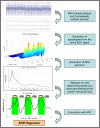Never resting brain: simultaneous representation of two alpha related processes in humans
- PMID: 19096714
- PMCID: PMC2602982
- DOI: 10.1371/journal.pone.0003984
Never resting brain: simultaneous representation of two alpha related processes in humans
Abstract
Brain activity is continuously modulated, even at "rest". The alpha rhythm (8-12 Hz) has been known as the hallmark of the brain's idle-state. However, it is still debated if the alpha rhythm reflects synchronization in a distributed network or focal generator and whether it occurs spontaneously or is driven by a stimulus. This EEG/fMRI study aimed to explore the source of alpha modulations and their distribution in the resting brain. By serendipity, while computing the individually defined power modulations of the alpha-band, two simultaneously occurring components of these modulations were found. An 'induced alpha' that was correlated with the paradigm (eyes open/ eyes closed), and a 'spontaneous alpha' that was on-going and unrelated to the paradigm. These alpha components when used as regressors for BOLD activation revealed two segregated activation maps: the 'induced map' included left lateral temporal cortical regions and the hippocampus; the 'spontaneous map' included prefrontal cortical regions and the thalamus. Our combined fMRI/EEG approach allowed to computationally untangle two parallel patterns of alpha modulations and underpin their anatomical basis in the human brain. These findings suggest that the human alpha rhythm represents at least two simultaneously occurring processes which characterize the 'resting brain'; one is related to expected change in sensory information, while the other is endogenous and independent of stimulus change.
Conflict of interest statement
Figures





References
-
- Niedermeyer E, Silva FLd. Electroencephalography: Basic Principles, Clinical Applications, and Related Fields. Lippincott Williams & Wilkins; 2005.
-
- Pfurtscheller G, Silva FHLd. Event-related EEG/MEG synchronization and desynchronization: basic principles. Clin Neurophysiol. 1999;110:1842–1857. - PubMed
Publication types
MeSH terms
LinkOut - more resources
Full Text Sources
Other Literature Sources

